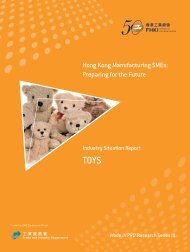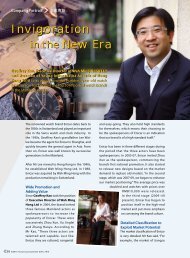Hong Kong Manufacturing SMEs: Preparing for the Future
Hong Kong Manufacturing SMEs: Preparing for the Future
Hong Kong Manufacturing SMEs: Preparing for the Future
- No tags were found...
Create successful ePaper yourself
Turn your PDF publications into a flip-book with our unique Google optimized e-Paper software.
99Central Governments, who set up research andtesting facilities.Differentiation StrategiesAno<strong>the</strong>r means of dealing with cost increases is todifferentiate in order to gain some pricing flexibility.Approaches to differentiation include:• Improve product qualityCustomers often are willing to pay higherprices <strong>for</strong> demonstrably higher quality products.Depending on <strong>the</strong> industry, quality may bedefined by precision craftsmanship, speed,reliability, product life, fashion or design content,attractive appearance, image, incorporation ofmore advanced technologies, or customisation.The challenge is to provide higher quality that<strong>the</strong> customer values, can be achieved in a costeffective manner, and is difficult to imitate. <strong>SMEs</strong>often have a hard time developing <strong>the</strong> capabilitiesto produce products with demonstrably higherquality than those of competitors. It is alsonecessary to find ways of demonstrating superiorquality to customers.• Improve services to customersImproving services to customers can includeproviding just in time inventory management <strong>for</strong>customers, providing design services, providingrapid turnaround and delivery, and providingreliable supply. To <strong>the</strong> extent that <strong>the</strong> firm candistinguish itself from its competitors, it may beable to obtain some pricing flexibility. The key isthat <strong>the</strong> SME view itself not just as producing aproduct, but as producing value <strong>for</strong> <strong>the</strong> customerthat could go well beyond <strong>the</strong> product itself andcould involve special delivery conditions, inventorymatching, designing, and o<strong>the</strong>r activities as well.• Move from OEM to ODM or OBM productionMoving from OEM to ODM or OBM productioncan allow manufacturing <strong>SMEs</strong> to distinguish<strong>the</strong>mselves and obtain better prices. However,ODM requires <strong>the</strong> firm to invest in designcapabilities and OBM production requires <strong>the</strong>firm to invest in branding, marketing, anddistribution. This in turn requires substantialresources and capabilities that most <strong>Hong</strong> <strong>Kong</strong><strong>SMEs</strong> that started in OEM production do notpossess. To brand successfully, <strong>the</strong> companymust ei<strong>the</strong>r have or bring on board people with<strong>the</strong> appropriate marketing skills, must engage inconsumer research, and must develop a clear andconsistent message that is fully backed up by <strong>the</strong>quality of <strong>the</strong> product and <strong>the</strong> entire purchasingexperience of <strong>the</strong> consumer (including choice oflocations, types of outlets, packaging, displays,price points, and promotional material).• Tailor strategy to serve particular nichesBy definition, <strong>SMEs</strong> generally cannot supplyall types of customers. As a result, it is oftenbetter <strong>for</strong> <strong>SMEs</strong> to tailor <strong>the</strong>ir strategy to servingparticular niches, gaining distinctiveness and<strong>the</strong> ability to differentiate by understanding andserving <strong>the</strong> needs of customers in <strong>the</strong> targetniches better than competitors. In order to carryout this strategy, <strong>the</strong> SME must develop a deepunderstanding of <strong>the</strong> niche, <strong>the</strong>ir precise needs,and cost effective ways of meeting those needswhile distinguishing itself from competitors.• Supply high value market segmentsHigh value niches, with customers that may beless price sensitive than <strong>the</strong> mass market, provideparticular opportunities <strong>for</strong> pricing flexibility,but requires a firm to develop <strong>the</strong> capabilities toserve <strong>the</strong>se markets. The idea is that high valuesegments generally have buyers that do notpurchase on price alone. Appealing to customerswho want high per<strong>for</strong>mance, a specific image,exclusivity, special features, or o<strong>the</strong>r non-pricefeatures again requires products that meet<strong>the</strong> relevant criteria and companies that cancommunicate <strong>the</strong>ir appeal clearly.
















